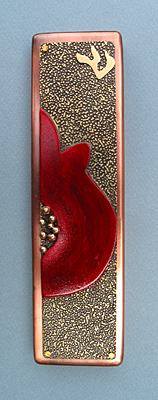Ruth Shapiro: Symbols of Judaica in Metal
 Handmade bronze mezuzah by Ruth Shapiro
Handmade bronze mezuzah by Ruth Shapiro Photograph courtesy of Ruth Shapiro
When an accident made it necessary for her to slow down, Ruth Shapiro found herself drawn to a course entitled, "Lost Wax Casting," even though she had no idea what it was or that it would change her life. Around that same time, she became more involved with her religion, so she focused her newfound artwork on Judaica.
Originally from New Jersey and now based in Los Angeles, Shapiro started creating copper, silver, and bronze mezuzot, which are traditionally hung on the doorpost of Jewish homes. She sometimes incorporates stones, geodes, beads, and carved bone, into her mezuzot and likes to work with recycled sheet copper whenever possible.
Since learning casting, Shapiro has studied many other techniques in her 25 years as an artist, including work with silver masters in Israel. Shapiro also makes jewelry, yodim, tallit clips, and occasionally, menorahs and synagogue pieces such as torah breastplates.
"In the last few years, I'm doing a lot more fabricating directly from sheet metal," she says.
Shapiro's work is very diverse, and not all of her mezuzot are in the traditional rectangular shape. Every mezuzah includes the first letter of the word Shalom, which means "peace," and some of her pieces include representations of the burning bush, as well as other Hebrew letters. She also likes to create different forms of the Star of David.
Earlier this year, the Oshman Family Jewish Community Center in Palo Alto, California awarded Shapiro a commission, which involved large custom-designed mezuzot in copper, brass, and bronze with a deep red pomegranate on the front. In addition to the mezuzot created for the center's building, she made 160 smaller versions of the same design that were given to the center's supporters.
When presenting her ideas to the center, Shapiro showed them a Hopi Indian technique called granulation that utilizes metal filings to create a pebbly effect. Replicating this technique on large surfaces wouldn't be possible, however, because the underlying pieces would start to melt before the filings fused. So, Shapiro created the same effect on the surface of the mezuzot through etching.
 Copper mezuzah with sunflower accents
Copper mezuzah with sunflower accents Photograph courtesy of Ruth Shapiro
Adding the pomegranate to the top of each mezuzah involved cutting the shape with a jeweler's saw and soldering it to the base. She then polished and lacquered each mezuzah and sanded the lacquer off the pomegranate portion. Then, she used a sulphur patina on just the pomegranate, treated it with steel wool, added four coats of metal dye, and sprayed it with lacquer. After letting it set for a week, she treated it with wax.
Because she only had two and a half months to complete the entire commission, the 160 small mezuzot were created from a wax mold, but each one is still slightly different. "It was a challenge," says Shapiro, "but I like the idea that they're going to be in 160 separate homes."
Most of her work is a result of inspiration from nature and Judaism, however, rather than commissions. "I like doing big jobs for people," Shapiro says, "but it's a little less nerve-wracking if I can take my time and do my own concept and hope that somebody will like it." These concepts include a mezuzah which she has humorously called a "ChiPod." Chi is a Hebrew letter meaning "life," and the piece looks like an iPod. Another of her own creations is a very intricate wedding mezuzah in sterling silver. She spent two years on and off carving the original wax mold.
Shapiro has also begun making her own copper beads, which she often etches. "I take sheet copper, and I cut out shapes - either rectangles, squares, or circles," she says. "I hammer the copper and dome it and then, solder two halves together. Sometimes, I'll texture the copper with a hammer first before I dome it. Other times, I etch it with a chemical, and then, when that's finished, I dome it. Then, I can oxidize it which makes the parts that are sunken in dark so that the pattern stands out more."
Shapiro mostly sells her work at Rabbinical or Jewish educator conventions or at high-end trade shows. She has just started selling to individuals on Etsy, but she also sells through her own website and some Judaica websites, galleries, and synagogue gift shops in the U.S. and Israel.
Shapiro's work is a spiritual experience for her that has deepened her connection to her religion, and as a result, she now enjoys collecting the work of other Judaic artists.
Resources:
Also in this Issue:
- The Brass Tacks of Steampunk
- Erickson Birdhouses: Weathering the Seasons Beautifully
- Copperhand Studio: In Partnership with Nature
- Ruth Shapiro: Symbols of Judaica in Metal
- Christie's Presents: Historical Design Reflects-The East 61st Street Years
